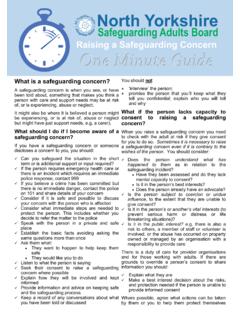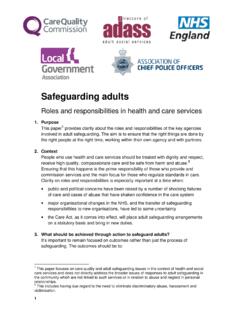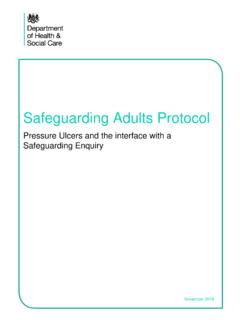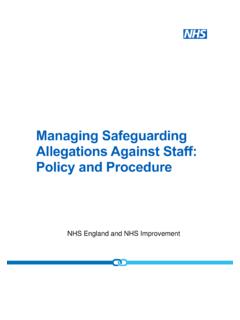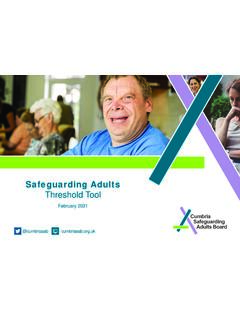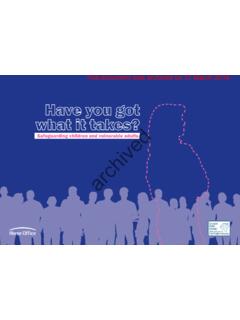Transcription of NORTHERN IRELAND ADULT SAFEGUARDING …
1 NORTHERN IRELAND ADULT SAFEGUARDING PARTNERSHIP. ADULT SAFEGUARDING Operational Procedures adults at Risk of Harm and adults in Need of Protection September 2016. CONTENTS. SECTION A: INTRODUCTION. Introduction Scope of Operational Procedures How to Use the Operational Procedures. Definitions Abuse Related Definitions adults at Risk of Harm adults in Need of Protection SECTION B: adults AT RISK OF HARM. The ADULT SAFEGUARDING Champion (ASC). Which Organisations Need an ASC? The Role of the ASC. Key Responsibilities of the ASC. Information to be Monitored by an ASC. Use of the ADULT SAFEGUARDING Position Report Recognising and Responding to SAFEGUARDING Concerns When an ADULT at Risk Discloses Abuse Responding to Concerns the Role of the ASC.
2 Responding to Concerns the Role of the HSC Trust Determination of an ADULT at Risk Determination if the Threshold for Referral to the HSCT rust ADULT Protection Gateway Service is met Alternative SAFEGUARDING responses Capacity and Consent The Decision Making process Consent Dispensing with Consent Acting Without Consent in Emergency Situation Capacity SECTION C: adults IN NEED OF PROTECTION. 8. Roles and Responsibilities 9. Procedures 10. Stage 1 Screening the ADULT Protection Referral 11. Stage 2 Strategy Discussion Meeting 12. Stage 3 Investigation/Assessment 13. Stage 4 Implementation of the Protection Plan 14. Stage 5 Monitoring and Review 15.
3 Stage 6 Closure 16. Large Scale and Complex Investigations APPENDICES. 1. References 2. Glossary of Terms 3. Health and Social Care Trust ADULT SAFEGUARDING Contact Details 4. Six Stages of the ADULT Protection process 5. Factors for Consideration in Determining Whether Harm has Become Serious Harm 6. Possible Outcomes 7. Risk Assessments HSC Trusts 8. Regional Documentation SECTION A. INTRODUCTION. 4. 1. Introduction Scope of the Operational Procedures The responsibility for enacting the procedures to protect adults from harm caused by abuse, neglect or exploitation is principally the responsibility of Health and Social Care Trusts (HSC Trusts) and, where a crime is suspected or alleged, the Police Service of NORTHERN IRELAND (PSNI).
4 However, SAFEGUARDING is everyone's business. These procedures are intended for use by all organisations working with, or providing services to, adults across the statutory, voluntary, community, independent and faith sectors. This includes paid staff and volunteers. They describe what organisations need to do to provide a safe environment and how to respond appropriately to situations where an ADULT is at risk of being harmed or abused. These procedures should be read in conjunction with all other relevant policies, such as: ADULT SAFEGUARDING : Prevention to Protection in Partnership Policy (DHSSPS. 2015). Protocol for Joint Investigation of ADULT SAFEGUARDING Cases (NIASP 2016).
5 SAFEGUARDING is a broad continuum of activity. It ranges from the empowerment and strengthening of communities, through prevention and early intervention, to risk assessment and management, including investigation and protective intervention. At all stages along this continuum, SAFEGUARDING interventions will aim to provide appropriate information, supportive responses and services which become increasingly more targeted and specialist as the risk of harm increases. SAFEGUARDING includes activity which prevents harm from occurring and activity which protects adults at risk where harm has occurred. The diagram overleaf outlines this continuum 5.
6 THE ADULT SAFEGUARDING CONTINUUM. Prevention SAFEGUARDING Response Protection All adults adults at Risk adults in Need of Protection Services provided to all adults by the public Targeted Services - Protection Services - led by and private sector, accessible by all. provided by a range of HSC Trust Social Workers Community and voluntary activities and statutory, voluntary, and/or PSNI. social welfare provided by voluntary, community, independent community, independent and faith sector and faith sector organisations. organisations. The continuum of ADULT SAFEGUARDING outlines the wide range of organisations involved in people's lives, from the small community activity groups through to larger organisations and statutory services.
7 All organisations should ensure that any service they deliver is underpinned by the principles of respect and treating others with dignity. This is the first and crucial step to ensuring that services are high quality. The focus is on the individual receiving the service which may help to provide support and that harm is prevented. Increasing levels of need and risk are likely to lead to greater targeting of service provision, which, in turn, requires a heightened awareness of risk of harm and more robust measures will be required to prevent harm. These procedures outline the actions needed to respond to adults at risk of abuse or harm.
8 6. How to Use the Operational Procedures. These procedures set out broad principles of good practice when responding to situations where adults are at risk or in need of protection. They place the ADULT at the centre of the SAFEGUARDING process and provide some practical guidance on how specific roles such as the ADULT SAFEGUARDING Champion should be implemented. The procedures support professional decision-making, placing a responsibility on practitioners to respond to each individual and their unique circumstances. Each response should be tailored to meet the needs of that individual, working towards the achievement of their preferred outcome.
9 The procedures do not describe every potential SAFEGUARDING scenario and some, such as those involving Domestic Violence or Modern Slavery, require more specialist responses. Guidance on these responses is available elsewhere and practitioners should refer to such detailed advice as necessary. 2. Definitions What is Abuse? Abuse is a single or repeated act, or lack of appropriate action, occurring within any relationship where there is an expectation of trust, which causes harm or distress to another individual or violates their human or civil rights'1. Abuse is the misuse of power and control that one person has over another.
10 It can involve direct and indirect contact and can include online abuse. The main forms of abuse are: Physical abuse 1. Action on Elder Abuse: definition of abuse 1993 which can be accessed at: This was later adopted by the World Health Organisation - 7. Physical abuse is the use of physical force or mistreatment of one person by another which may or may not result in actual physical injury. This may include hitting, pushing, rough handling, exposure to heat or cold, force feeding, improper administration of medication, denial of treatment, misuse or illegal use of restraint and deprivation of liberty. Female genital mutilation (FGM) is considered a form of physical AND sexual abuse.


